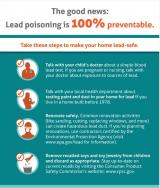Protect Your Children
Lead exposure and lead poisoning are preventable – you can take actions to protect your children and prevent them from coming into contact with lead before they are harmed including:
For more information about protecting your family from exposure to lead:
Test Your Child
No safe blood lead level in children has been identified. Find out if your child has elevated levels of lead in his or her blood. Because an elevated blood lead level often occurs with no obvious or immediate symptoms, it frequently goes unrecognized. You can get your child tested for lead by asking your pediatrician to do a simple blood test. Children with elevated blood lead levels can have serious health effects. If you know your child has an elevated blood lead level, then talk to your pediatrician and local health agency about what you can do. The CDC also provides informationExit about blood lead testing and what to do if your child has an elevated blood lead level.
Check the Condition of Schools and Child Care Facilities
Although your home may be free of lead-based paint hazards, your child could be exposed elsewhere, particularly if they spend time in a building built before 1978. Ask your child's school board or facilities manager if they regularly inspect for lead hazards. Here is a list of places to look:
- Interior painted areas - Examine walls and interior surfaces to see if the paint is cracking, chipping or peeling, and check areas on doors or windows where painted surfaces may rub together.
- Exterior painted areas - Check exterior paint. It can flake off and contaminate nearby soil where children may play.
- Surrounding areas - Be sure there are no large structures nearby with peeling or flaking paint that could contaminate the soil around play areas.
- Cleaning practices - Make sure the staff wash pacifiers, toys or bottles that fall on the floor. Also, make sure the staff have the children wash their hands with soap after playing outside and before eating or sleeping.
- Play areas - Look to see if areas where children play are dust-free and clean. Outside, check for bare soil and ask about testing for lead.
- Playground equipment - Older equipment can contain lead-based paint.
- Painted toys and furniture - Make sure the paint is not cracking, chipping or peeling. Inquire about whether a child care center's toys comply with the requirements of the Consumer Product Safety Commission (CPSC). Exit
- Ask about testing all of the drinking water outlets in the facility and on the playground, especially those that provide water for drinking, cooking and preparing juice and infant formula. Read more about drinking water in schools and child care facilities.

